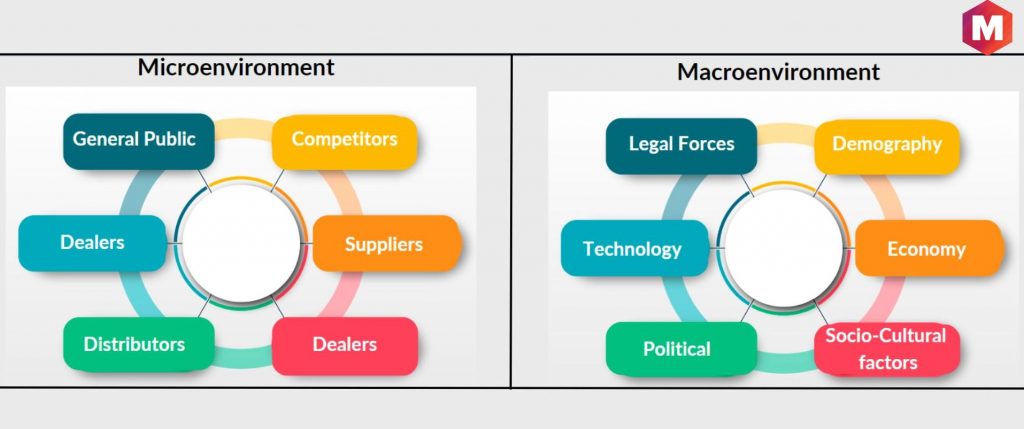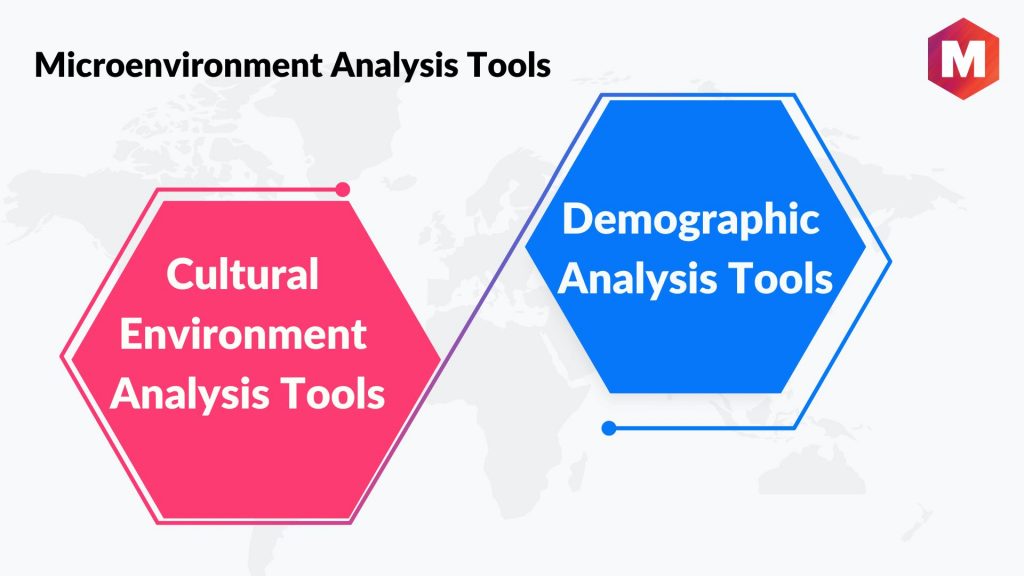Definition: Micro environment is the immediate environment of a business, which includes factors like employees, customers, competitors, suppliers, marketing intermediaries, etc, and can influence daily business operations.
It is a collection of variables and factors that affect the immediate environment of a business organization. These micro-environments are usually local and immediate, as opposed to the macro-environments which can be global or outside the company’s direct control like the natural environment or political environment.
Table of Contents
What is a Microenvironment?
The term microenvironment refers to all of the elements of an organization’s immediate environment that influence the performance of the company. These factors have a direct bearing on the firm’s regular business operations.
In other words, a micro-environment is like a small environment that contains many different things such as people, resources, and tasks. The micro-environment can be defined as a part of a larger system or unit that has its own boundaries within which it operates.
The micro-environment can be defined as a part of a larger system or unit that has its own boundaries within which it operates. The micro-environment comprises all those factors that influence a company’s ability to perform directly or indirectly and are considered as its immediate surroundings.
Difference between Micro and Macro Environments
When an organization starts its business in the market, its success and sustenance are shaped by several factors. While some of these factors are beyond the control of the company, others can be brought within its grip.
The former is known as external factors which form the macro environment factors and the latter encompassing the internal factors, is referred to as the micro environment.
Demography, economy, Social and Cultural factors, political and legal factors, natural resources, and technology are collectively known as macro environment factors.
On the other hand, consumers, competitors, suppliers, dealers and distributors, and the general public together constitute the micro environmental factors.
Micro environment components are within the immediate surroundings of the organization. These are the initial spheres to work on, to shape a strong and credible image of the company in the larger or macro environmental factors.
A perfect collaboration of micro and macro environments contributes to a successful and consistent business operation. If one end is disturbed, the other end suffers by default. It is because the internal factors are components of the external ones. Hence any problem within the macro environment will gradually reflect in the micro front. At the same time, if the micro environment is not under control, it will destabilize the macro environment components for the particular business.
For example, in the event of economic environment downfall or financial emergency in a nation, demand, and supply of any commodity is hard to hit. This in turn affects business profits and brings down its prospects. A similar scenario is also possible when suppliers or the supply chain technology of a product gets hampered. As a result, products become inaccessible to consumers. This certainly threatens the technological and to some extent the demographic environment.
Therefore in micro and macro factors, to stand apart in any commercial venture or business environment, marketing management and marketing intermediaries need to understand the significance of each of these components and work towards maintaining a proper balance between the two environments.
Role of Micro Environment in Business
The micro environment is the first pillar of building a business empire. All marketing campaigns, strategies, and objectives are carried out through these components. It is, therefore, the executive arm of business where practical implementation of ideas, thoughts, and concepts are done, and based on the responses of these components, a business either moves forward or may step back.
Further, it serves as a guide to future communication policies of an organization. With all such features, the micro environment plays an integral role in realizing the current potential and determining the future of a business.
With a significant contribution to the overall functioning of a business, here’s how the components enjoy an interface with core business development.
Micro Environment Factors
Some of the elements of micro environment that influence a business are –
1. Customers
The term includes everyone from individuals to households to service recipient companies to industries and factors (which procure raw materials for producing final goods). As the God of every business, they have the potential to boost business activities by increasing their demand and at the same time ruin an organization by refusing to purchase its products.
Presently, every customer is open to choices. Thus, the real challenge of a marketer is to withhold the consumer within the company’s business and make efforts to form a consumer chain, that is, one consumer influences others to purchase the company’s products.
2. Competitors
Whether direct or indirect, competitors pose a threat to the existence of every organization. With more competitors, customers are sure to browse some other rather better quality and cost-effective options. While doing so, there are high chances of losing a customer to one or many competitors.
In such a case, the company’s marketing environment has to devise communication in a way that will surpass the effect of competitors’ promotional efforts and retain the customer for the particular brand or product.
3. Suppliers
They are the ones who supply intermediary products to the manufacturers of finished goods. For example, a computer or laptop manufacturing company will take all the necessary parts and technology from its suppliers.
The quality of these go-between commodities, the price charged by the suppliers, and the supplier-manufacturer relationship determine the price and brand image of the electronic goods- a key player in attracting the audience and sustaining in the market under any condition. Often, companies get into a tussle with their suppliers who ask for higher prices. Such issues often leave the organization at sea and become a testing time for its business.
4. Dealers and Distributors
With the help of dealers and distributors, a company channelizes its products from the manufacturing units to the market. As this group represents the company, their active role in delivering the products to the end-user and ensuring that commodities are well in stock and easily available in stores retails or other access points is vital for business establishment.
As an example, a consumer can purchase a cosmetic product from their nearest retail or cosmetic shop. They can also hop into shopping malls or do online shopping. Therefore, the utmost responsibility of the management is to ensure that the cosmetics are available in all these places and customers don’t return without purchasing their desired product.
5. Investors
They are the prime assets of an organization. The more they invest, the more a company becomes capable of spending in its various departments. Investor relationship is very vital in this context. If they are happy with the product performance and get regular ROIs, they will, in all probability invest a higher amount for more returns.
Hence, besides satisfying the customers, companies also need to look after their investors and waste no means to retain them within the organization’s fold.
6. Marketing intermediaries
Inevitable for business success, marketing intermediaries play a crucial role in connecting the dots between product manufacture and its target market. They stand as an intermediary between the producer and consumer, supplying products to customers while helping boost sales of companies.
Intermediaries” in this context refers to various types of middlemen involved in the company’s supply chain such as agents, merchants, distributors, dealers, and wholesalers. Their role is to stock and transport goods from the source to the destination.
7. Shareholders
Shareholders can also be referred to as stakeholders. They are the actual owners of the company and have a direct relationship with it. Shareholders or stakeholders have the right to vote and take part in decision making when it comes to company affairs. They expect the management of a company to act ethically and rationally with respect to their investments.
8. Employees
Possibly the most important component of an organization, employees are its valuable resources. The way a company manages and values its employees speaks volumes about its culture and character. Without motivated and efficient employees, a company can never reach its full potential or operate at an optimal level. This is why companies should ensure their employees are provided with training, resources, and good working conditions which will make them feel valued and respected.
9. Media
Widespread media coverage is essential for any business to survive and thrive. Media can be a powerful tool in the hands of marketers as it helps shape public opinion and create awareness of products or services. However, media can also be used as a source of criticism for companies if their activities are deemed unethical. Managing media is essential for companies, especially in today’s digital age.
Microenvironment Analysis Tools
A Microenvironment Analysis Tool is a tool used to analyze the economic environment that surrounds your business. The microenvironment is the area surrounding your business, and it includes factors like demographics and culture.
There are several types of Microenvironment Analysis Tools:
- Demographic Analysis Tools: These tools help you understand the economic factors and what kind of people live in your business’s neighborhood. For example, if you have a bakery that serves coffee and pastries, you might want to know what kind of customers you have based on their age or race.
- Cultural Environment Analysis Tools: These tools help businesses understand how people in their area think about things like religion or politics. For example, if your bakery is located near an apartment building for college students, then it might be helpful for you to know what religious holidays are important to them so that they can plan appropriately for those days when fewer people will be coming into the store.
Want to boost your business’s success?
Invest in employee engagement: Your employees play a critical role in shaping your micro environment. According to Gallup’s 2022 report, organizations with high employee engagement see a 21% increase in profitability compared to those with low engagement. Fostering a supportive workplace culture can lead to better performance and reduced turnover.
Prioritize customer experience: Engaging with customers and understanding their needs enhances loyalty and satisfaction. A 2018 study by PwC found that 73% of consumers say customer experience is a key factor in their purchasing decisions. Regular feedback and personalized services can significantly improve your relationship with customers.
Liked this post? Check out the complete series on Marketing


Hi Hiten….thanks for your magnanimity for dissemination of important message thru M91….will keep in touch tgru mail as I seldom use Fakebook…
I am happy with the Bhasinbrand of M91.
What an innovative method of teaching.
thanx
Thanks a lot it helped with my assignment
Please what is your writing references??